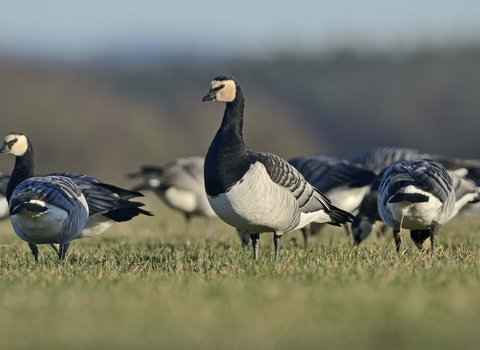
©David Tipling/2020VISION
Barnacle goose
The black-and-white barnacle goose flies here for the 'warmer' winter from Greenland and Svalbard. This epic journey was once a mystery to people, who thought it hatched from the goose barnacle at sea!
Enw gwyddonol
Branta leucopsisPryd i'w gweld
October to MarchGwybodaeth am rywogaethau
Categori
Ystadegau
Length: 58-68cmWingspan: 1.3m
Weight: 1.7kg
Average lifespan: 14 years
Classified in the UK as Amber under the Birds of Conservation Concern 5: the Red List for Birds (2021).
Cynefinoedd
Ynghylch
The barnacle goose is one of our smallest geese, with a relatively small, rounded head and a very short bill. A common winter visitor to the north-west of the UK, in particular, it grazes on vegetation, such as roots, stems, leaves and seeds.Sut i'w hadnabod
A small goose, with a creamy-white face, a black neck, black-and-grey wings, and a white belly. Unlike the Canada goose, the barnacle goose has no brown on it at all.Dosbarthiad
Wild birds are only found here in the winter. They nest in Greenland and Svalbard and spend the winter in Scotland, northern England and Ireland. Small numbers of feral birds nest on gravel pits and park lakes.Roeddech chi yn gwybod?
It was once thought that barnacle geese hatched out of goose barnacles attached to ships at sea - their shells washing up on the west coast of Scotland in the autumn. This belief grew because goose barnacles have black-and-white stripes (like the geese) and the nests of barnacle geese were never seen. As a result, people even considered the barnacle goose acceptable to eat on Fridays and during Lent, despite the Church's ban on eating meat at these times, because it was not 'born of the flesh'.Gwyliwch
Barnacle Goose (https://vimeo.com/444195430)
Barnacle Goose by John Bridges
